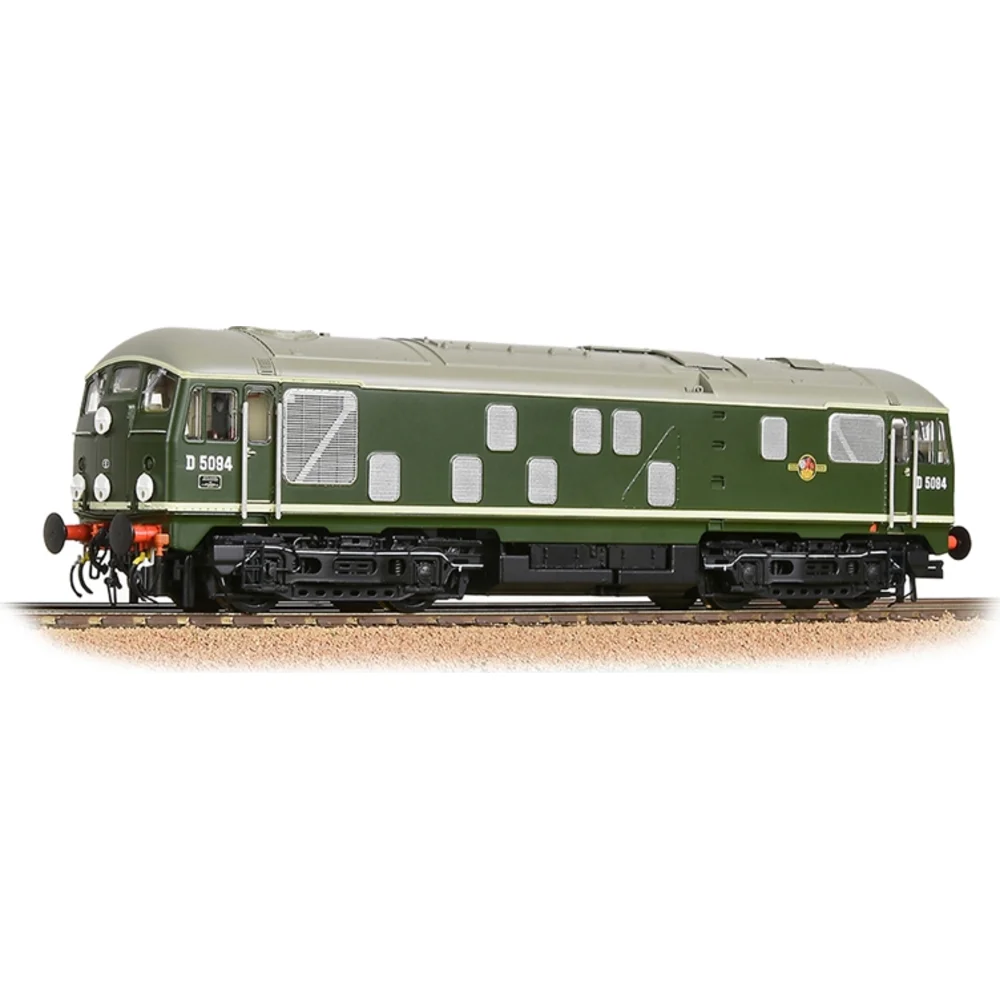Bachmann 32-443SF
British Rail Class 24/1 D5094 British Railways Green with Late Crest
Tooling
In 2020, Bachmann Branchline unveiled a comprehensive retooling of its British Rail Class 24 diesel-electric locomotive in OO gauge (1:76 scale). This update replaced the 2008 tooling and introduced two distinct body styles: the Class 24/0 with disc headcodes and the Class 24/1 with cab roof-mounted headcode boxes. The new tooling was designed to meet modern expectations for fidelity, performance, and digital control, reflecting extensive research into prototype variations.
Tooling Features
The 2020 tooling introduced a new bodyshell with factory-fitted fine details including etched fan grilles, lamp irons, handrails, roof hatches, and filler caps. Cab interiors were fully detailed and painted, featuring crew communication doors, seating, and control panels. A comprehensive detailing pack was included, offering bufferbeam pipework, jumper cables, cosmetic screwlink couplings, and frost grilles. Sprung buffers and NEM coupling pockets were standard, with tension lock couplings pre-fitted.
Mechanical & Electrical
The model featured a centrally mounted 5-pole motor driving all eight wheels via a refined gear train. The chassis was constructed from plastic and metal, with internal weighting for improved traction. Electrical pickup was provided on all wheels, and the model operated on standard 2-rail DC. Directional lighting was standard, with independently controlled headlights, tail lights, and illuminated headcodes. The minimum radius for operation was second radius (438mm).
DCC Capability
The 2020 tooling was DCC Ready with a 21-pin socket and provision for a 20x40mm rectangular speaker. Several models were released with factory-fitted sound decoders. The internal layout supported additional lighting functions and speaker upgrades. Users commonly installed Zimo MX644 or ESU LokSound decoders, with options for SugarCube or Dumbo speakers. Cab lighting and SuperCap installations were also supported by the onboard PCB design.
Liveries Produced
Liveries released under the 2020 tooling included:
- BR Green with Late Crest
- BR Green with Small Yellow Panels
- BR Blue
- BR Research Department Red & Blue ("Experiment")
Both standard and sound-fitted versions were produced, with some custom weathered editions available through retailers and detailing services.
Reviews & Commentary
The 2020 update was widely praised for its accuracy, running quality, and digital features. Reviewers highlighted the smooth operation, realistic lighting, and sound fidelity. The model was noted for its ability to haul long rakes with ease and for its quiet motor performance. Some minor criticisms were raised regarding the seam beneath the nose on the Class 24/0 variant, but overall reception was highly positive. The model was featured in Hornby Magazine, Railway Modeller, and numerous YouTube reviews.
Media & Social Media
The model gained strong traction on social media and YouTube, with reviewers showcasing its sound functions, lighting, and haulage capabilities. Videos from Sam’s Trains and Worthington Model Railway highlighted the model’s unexpected inclusion of sound decoders in some releases and its ease of programming. RMweb discussions focused on speaker upgrades and decoder tuning, with users sharing installation guides and performance tips.
Class & Prototype
- Class: British Rail Class 24/1
- Traction: Diesel
- Transmission: Electric
- Built: 1959-1961
- Total Built: -
No prototype found.
Operator & Livery
- Operator: British Railways
- Livery: Green with Late Crest
British Railways transformed Britain's fragmented rail network into a unified national system following nationalisation on 1st January 1948. Created from the "Big Four" companies under the Transport Act 1947, BR operated most of Great Britain's railways until rebranding as British Rail in 1965, managing over 20,000 route miles and inheriting nearly 20,000 locomotives of diverse designs.
The organisation pioneered standardisation through its revolutionary BR Standard locomotive programme (1951-1960), producing 999 advanced steam engines under Robert Riddles' direction. These included the versatile Britannia Pacifics, mighty 9F freight engines, and mixed-traffic classes that incorporated the best features from all predecessor companies. The 1955 Modernisation Plan accelerated diesel and electric traction development, creating fascinating mixed-traction operations.
Notable achievements included establishing unified locomotive classification systems, introducing distinctive corporate liveries, and managing the complex transition from steam to modern traction. BR's six regional structure preserved operational diversity whilst enabling standardisation of practices, signalling, and rolling stock that had eluded private enterprise for over a century.
The BR era represents steam traction's final flowering alongside emerging diesel technology, creating unparalleled locomotive variety. Today, this heritage remains highly popular with railway enthusiasts through extensive preserved fleets, heritage railway operations, and comprehensive model ranges from manufacturers like Hornby, Bachmann, and Dapol, making BR subjects essential for authentic post-war British railway modelling across all scales.
